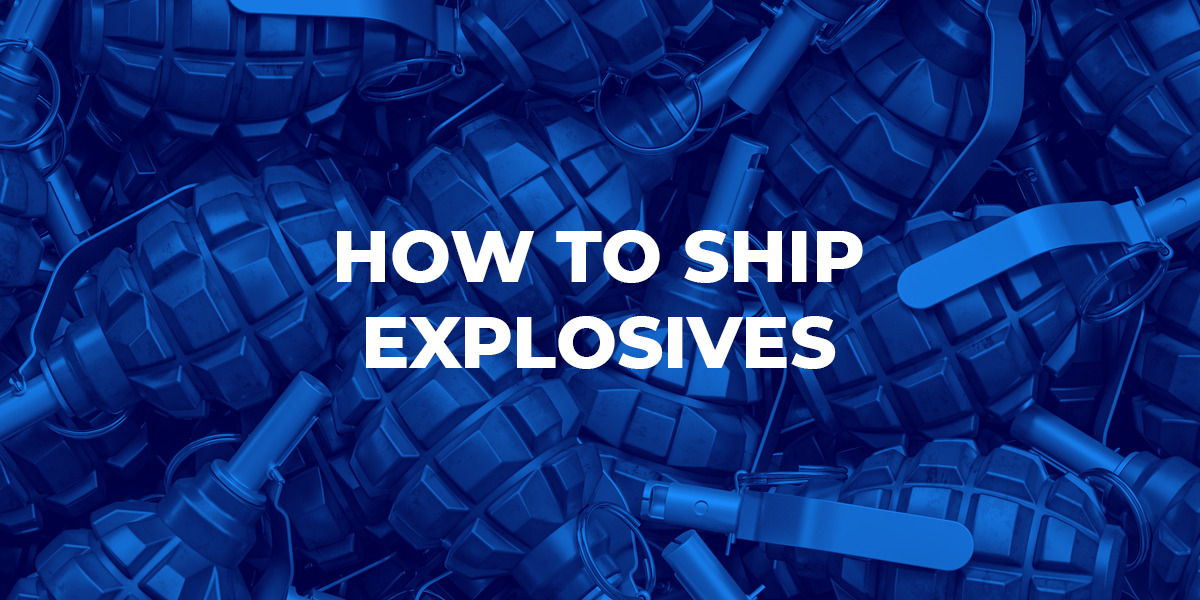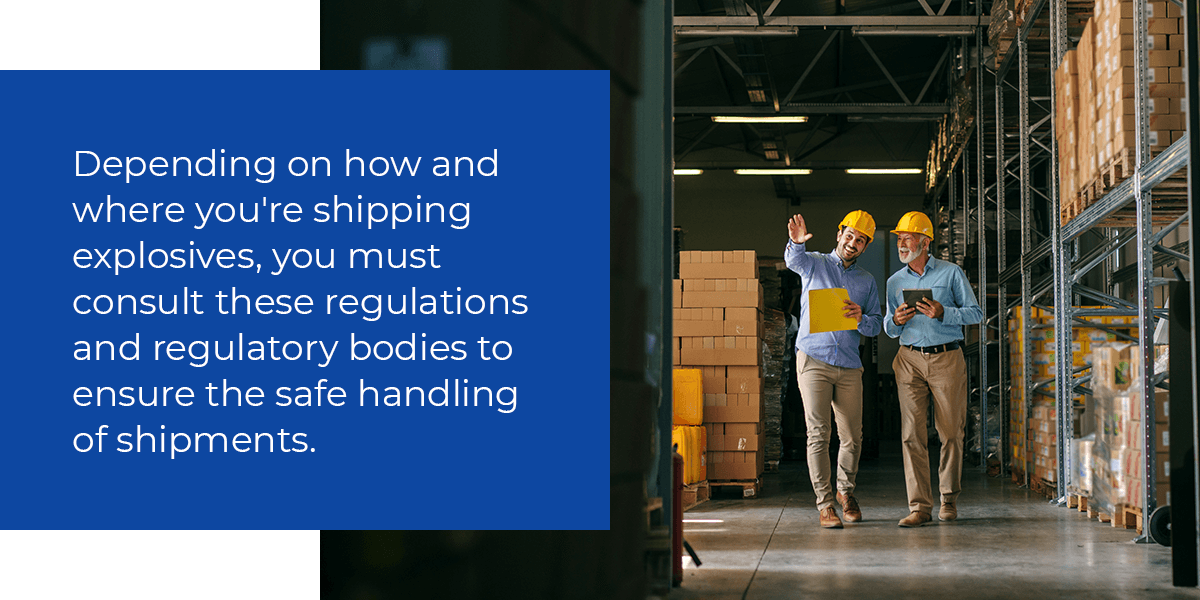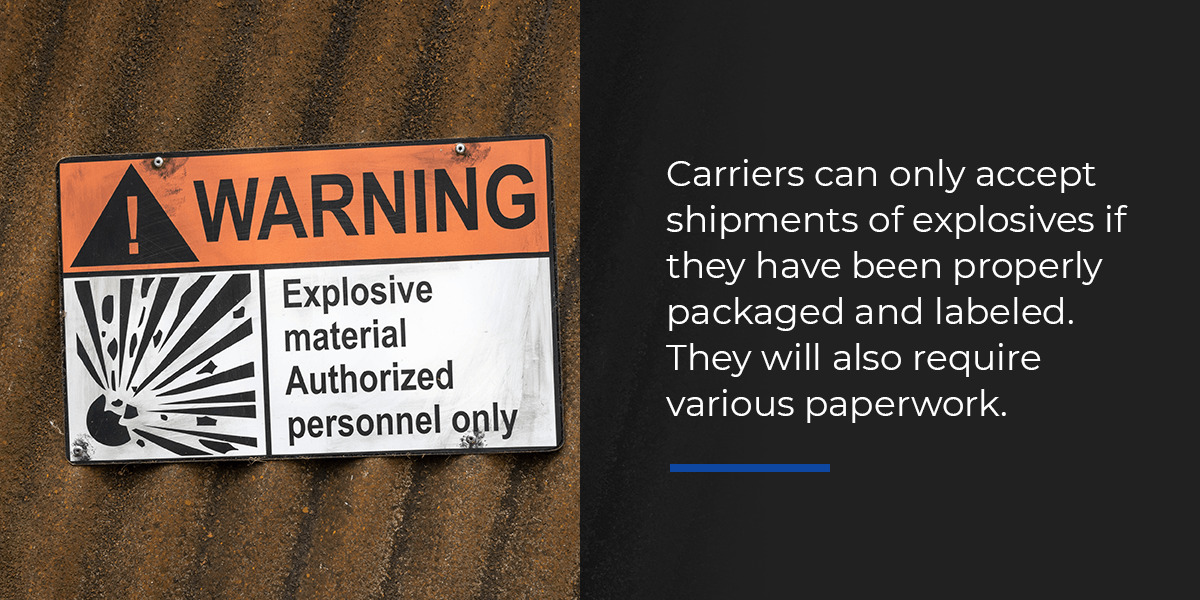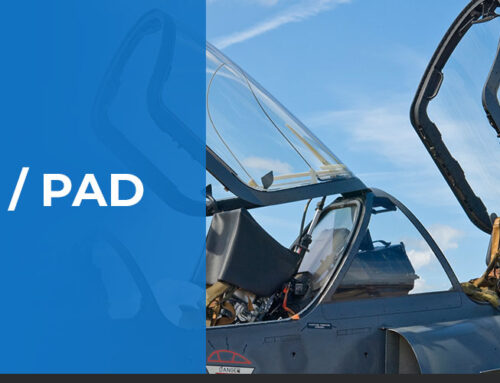You may need to purchase pyrotechnics for your aircraft or send some to your customers in commercial, private or military aviation. Or perhaps you have some other need for shipping explosives. Whatever the case, the task requires careful consideration. Although often required in various components of an aircraft, explosives can be hazardous and therefore more challenging to ship by air or even by ground or sea.
AETC has been shipping small explosive devices for aviation safety equipment to our customers for over 40 years. Since we’re well-versed in the process, we can give you the information you need to ship our products to your customers and serve any of your other explosives shipping needs in the aviation industry.
Table of Contents:
Different Classifications of HAZMAT
Hazardous materials (HAZMAT) break down into nine classifications, requiring different precautions and labeling during shipping.
Class 1 — Explosives
Class 1 is likely the category your shipment will fall into if you are shipping explosives. Class 1 includes several divisions, such as:
- Division 1.1: This division includes explosives with a mass explosion hazard. A mass explosion refers to an explosion that could instantaneously affect the entire load. Division 1.1 products include desensitized nitroglycerine, dynamite, torpedoes and mercury fulminate.
- Division 1.2: Explosives that do not have a mass explosion risk and instead have a projection hazard fall into division 1.2. For example, detonating fuses, fireworks and some ammunition fall into this category.
- Division 1.3: Next, explosives with a fire hazard alongside a minor blast or minor projection hazard or both classify as division 1.3, so long as they have no mass explosion risk. Some liquid and solid propellants and rocket motors fall into this category, alongside sodium picramate.
- Division 1.4: Explosives with a minor blast hazard, such as common fireworks and empty primed grenades, fall into this category.
- Division 1.5: Very insensitive explosives with a mass explosion hazard classify as division 1.5 explosives. They include Type-E blasting agents alongside some Type-B blasting agents and any explosive substance that’s very insensitive.
- Division 1.6: Insensitive explosives without a mass explosion hazard fall into division 1.6.
Several explosives are forbidden and cannot be shipped at all. These goods include:
- Any explosives that have not gone through the appropriate approval
- Any explosive mixture or device containing a chlorate and ammonium salt or an acidic substance
- A leaking or damaged package or article that contains an explosive
- Unstable, condemned or deteriorated propellants
- Nitroglycerine, diethylene glycol dinitrate or any other liquid explosive that hasn’t been explicitly authorized
- Loaded firearms
- Fireworks that contain both an explosive and a detonator
- Fireworks that contain yellow or white phosphorus
- Certain toy torpedoes
- Other explosives that are explicitly forbidden in 49 CFR
- Any explosive with its means of ignition or initiation installed, unless approved according to 49 CFR
Class 2 — Gases
Class 2 HAZMAT refers to gases. Gases in Class 2 break down into flammable, non-flammable, poison and corrosive gases. They can include aerosols, such as hairspray and household cleaners, propane tanks, pepper spray and fire extinguishers. However, fire extinguisher squibs or cartridges are considered small explosives.
Class 3 — Flammable Liquids
Next, Class 3 includes flammable liquids categorized according to the temperatures at which they could ignite if they come into contact with a flame. These products could consist of nail polish, lighter fluid, oil-based paints and gasoline.
Class 4 — Flammable Solids
Class 4 is for solid products that can catch fire when they come in contact with a flame. Flammable solids also include combustible materials and materials that are dangerous when wet. Common flammable solids include sulfur, fish oil, matches and sodium batteries.
Class 5 — Oxidizers or Organic Peroxides
Oxidizers and organic peroxides, which fall into Class 5, are chemicals that will produce oxygen in chemical reactions, which means they can cause combustion or fan the flames of an explosion or fire. Some of these products include hydrogen peroxide, ammonium nitrate fertilizers, bleach and chlorine.
Class 6 — Toxic and Infectious Substances
Toxic products that can cause loss of life, severe injury or illness to humans if inhaled or ingested fall into Class 6. Some examples include arsenic, nicotine and pesticides. This category also includes infectious substances like bacteria, fungi and viruses. A common example of an infectious substance in Class 6 is biomedical waste such as used needles.
Class 7 — Radioactive Material
Radioactive material is anything that gives off spontaneous ionizing radiation. Class 7 HAZMAT materials can include X-ray machines, depleted uranium and medical isotopes.
Class 8 — Corrosives
Corrosive materials, liquids and solids can cause destruction and irreversible changes to human skin. Meanwhile, liquid corrosives also cause severe corrosion to steel or aluminum. Class 8 corrosives include hydrochloric acid, sulfuric acid, drain cleaner, mercury thermometers and paint strippers.
Class 9 — Miscellaneous Hazardous Materials
All other hazardous materials fall into Class 9. This category is reserved for any other material that can pose a hazard during shipping, such as vehicles, dry ice, lithium-ion batteries and first-aid kits.
HAZMAT Shipping Regulations
Shipping HAZMAT can be an involved process due to the safety risks they can pose on airplanes and cargo ships. The required steps include:
- Determining the HAZMAT class: More than likely, your explosives will fall into Class 1. You’ll need to determine which division of Class 1 your goods fall into.
- Discussing the shipment with your carrier: First, look for a carrier that can ship your explosives. Look at what division of Class 1 HAZMAT they can accommodate, noting any exceptions. Then, talk to your carrier directly to learn what the process looks like. They’ll likely have you go through some approvals or set up a special contract for the shipment. They will make you aware of any additional carrier requirements you must meet.
- Packaging the product: The Code of Federal Regulations, Title 49 (49 CFR), which governs HAZMAT shipping, includes detailed regulations on how you can package various explosives. You’ll want to consult 49 CFR and package your products based on the safety requirements for that material.
- Labeling the package: Your packages require the appropriate HAZMAT markings and symbols. If you’re shipping explosives, the labels must include the proper Class 1 label.
- Submitting additional paperwork: You and your carrier are both responsible for documenting the explosives being shipped. Fill out the appropriate paperwork as required by your carrier and ensure you’re documenting your shipments appropriately.
- Shipping the HAZMAT goods: Work with your carrier to ship the explosives or other HAZMAT products according to the arrangements you’ve agreed to.
While following this basic procedure, your shipment will also be subject to some additional regulations, such as:
- IMDG code: The International Maritime Dangerous Goods Code is the authority for international HAZMAT shipments by sea.
- ICAO and IATA: If you plan on shipping the goods by plane, you’ll have to consider regulations from the International Civil Aviation Organization (ICAO) and the International Air Transport Association (IATA). Both of these organizations put forth rules for shipping dangerous substances by air.
- 49 CFR: In addition to international regulations, you must also adhere to U.S. federal regulations. The 49 CFR lists specific requirements for preparing, handling and shipping hazardous goods. The Departments of Transportation and Homeland Security oversee these regulations.
Depending on how and where you’re shipping explosives, you must consult these regulations and regulatory bodies to ensure the safe handling of shipments.
Shipping Explosives in the U.S.
The safest and easiest way to ship explosives in the contiguous United States is via ground shipping. You’ll work with a carrier that can legally and safely transport your division of explosives, and they can help you understand the process in more depth.
What Carriers Ship Explosives?
Many major carriers ship HAZMAT, including explosives. They may place their own restrictions on what they will accept, so make sure you understand their rules and contact the carrier directly to determine if they can accept your particular explosives. More importantly, you must receive the appropriate EX Approval for the explosives you want to ship. Meanwhile, the Federal Motor Carrier Safety Administration (FMCSA) assigns carriers shipping HAZMAT such as explosives several responsibilities, which your carrier must comply with to accept your shipment.
Major carriers such as FedEx and UPS both accept explosives with some special requirements. For example, you must undergo an approvals process to ship explosives via FedEx Ground. FedEx ships 1.4 and 1.6 explosives, except for fireworks. UPS also accepts explosives and other HAZMAT for their contracted customers.
You’ll also have to meet various requirements as the shipper. For example, any employees that work with your hazardous materials need the appropriate HAZMAT training.
Explosives Packaging, Papers and Labels for Shipping
Carriers can only accept shipments of explosives if they have been properly packaged and labeled. They will also require various paperwork.
First, the packaging requirements include:
- The packaging materials must adhere to various regulations, including the United Nations Performance Oriented Packaging (UN POP) or 49 CFR.
- Packaging materials must be in new or “like new” condition.
- Any fiberboard non-specification packaging and outer packaging must meet a specific bursting test, either 200-lb, 250-lb or 275-lb, depending on the weight of the shipment.
- All containers with friction-fitted lids must have either a retaining ring or a certain number of lid clips depending on the size of the container.
- The explosives cannot be strapped, banded or taped into a bundle.
- Combination packaging for explosives cannot exceed the inner container requirements.
You must also correctly label and mark the packaging. Since your shipment contains explosives, the labeling must feature the appropriate orange Class 1 diamond label as required by FMCSA.
Your package markings must include:
- Your address
- The recipient’s address
- Your shipping name as designated by the U.S. Department of Transportation (DOT)
- The UN/NA Identification Number
Depending on the shipment, you may need markings. Those requirements include:
- Certain explosives and safety devices such as airbag modules, airbag inflators and seat belt pretensioners require EX numbers, national stock numbers and product codes on your shipping forms.
- If shipping explosives using a special permit from the DOT, your package must have the special permit number.
- If UN POP packaging is required, the packaging must include the UN POP code embossed on the packaging.
- When using an outer package, you must use a label or a handwritten mark that says “overpack.”
Finally, your carrier will indicate the required paperwork associated with your shipment.
Shipping Explosives Internationally
Shipping explosives internationally can be a greater challenge both because of the increased regulations and the increased risk. The requirements for shipping explosives by air or sea are similar, with a few distinctions.
Shipping by Sea
The IMDG code is the primary regulation shippers must adhere to for shipping by sea. In particular, the IMDG code section 2.1 lists the requirements for shipping explosives overseas.
According to International Maritime Organization standards, these requirements will include proper labeling, which follows the nine classifications for hazardous items. The organization also requires specific inner and outer packaging for the explosive substance. It’s critical that the specific hazardous material doesn’t weaken or interact with the packaging material.
Finally, these requirements indicate that the hazardous materials be properly segregated. If your explosives could react with other items aboard the vessel, they must be kept separate. The shipping carrier must have information on all the explosives you intend to ship, and anyone who will handle or work around your shipment must have training in HAZMAT and understand which items could potentially react.
Shipping by Air
Shipping explosives by air internationally follows similar regulations. However, shipping by air means meeting IATA requirements first and foremost. Items will need to feature the correct Class 1 label for explosives. HAZMAT, especially explosives, cannot ship aboard passenger aircraft and can only travel via cargo plane.
As with shipping by sea, the packaging will have to meet UN standards for hazardous goods. Similar to shipping by sea, there are specific rules for hazardous items governing which are groupable on the same flight. And finally, you’ll need to document your shipment in cooperation with your air carrier to ensure your explosives can ship safely and legally.
What Countries Can You Ship Explosives To?
If you’re based in the U.S., you should consult with your particular carrier to determine which countries they are approved to ship explosives to. Note that a country that you can legally ship HAZMAT to may have additional restrictions on explosives. According to some of the major international shipping carriers, you can ship explosives to the following countries.
- Austria: Only Division 1.4S explosives can be shipped.
- Bahrain: 1.4S and 1.4G explosives can be shipped, pending Ministry of Interior and Directorate General for Civil Aviation (DGCA) approvals for the recipient.
- Canada: Only Class 1.4 explosives can be shipped.
- Columbia: Contact your carrier for information on shipping explosives to Columbia.
- France: Only Division 1.4S explosives can be shipped.
- Germany: Only some Division 1.4S explosives can be shipped. Germany cannot accept explosives with UN numbers 0323, 0349, 0384 and 0481.
- Japan: Only Class 1.4 explosives can be shipped.
- Republic of Ireland: Only 1.4S explosives can be shipped.
- Kuwait: You can ship 1.4S and 1.4G explosives to Kuwait. However, the DGCA must approve the recipient.
- Liechtenstein: Only 1.4S explosives can be shipped.
- Monaco: Only 1.4S explosives can be shipped.
- Portugal: Only 1.4S explosives can be shipped.
- Puerto Rico: You can ship 1.4S explosives to Puerto Rico. However, these items must be designated “hold at location” (HAL).
- Slovenia: Only 1.4S explosives can be shipped.
- Spain: Only 1.4S explosives can be shipped.
- Sweden: You can ship all preapproved 1.4B and 1.4S explosives to Sweden.
- Switzerland: Only 1.4S explosives can be shipped.
- United Arab Emirates: Explosives shipped to the United Arab Emirates can be accepted as “receive over counter” (ROC) or HAL at Dubai International Airport only. All explosives shipments require preapproval and at least 48 hours of notice.
- United Kingdom: Only 1.4S explosives can be shipped.
Request Aviation Explosives From AETC
AETC offers a range of small explosives, such as those used in fire extinguisher cartridges and squibs, initiators, detonators and cutter cartridges. Our products are used in aviation safety equipment such as fire extinguishers and escape slides, and we’re approved by the Department of Defense (DOD), the Department of Alcohol Tobacco and Firearms (ATF) and the Federal Aviation Administration (FAA).
If you need any of these products for your military, commercial or private aviation manufacturing supply chain, contact the AETC team today. We can ship our small explosives quickly and safely to your facility and help you in transporting these goods throughout your supply chain.







